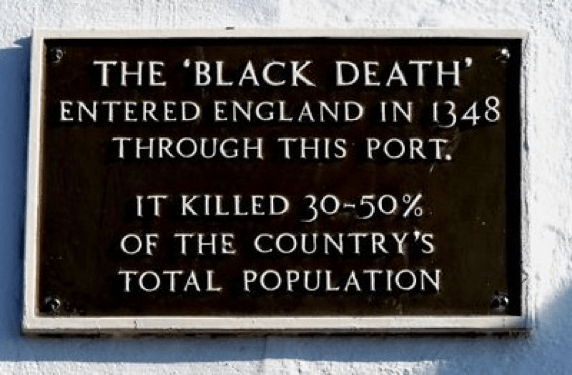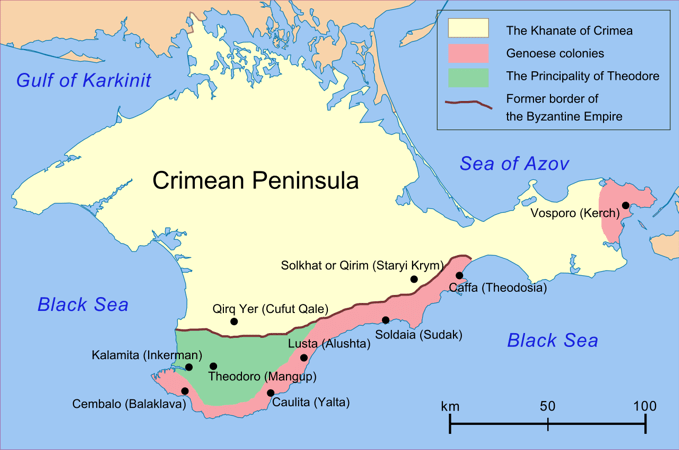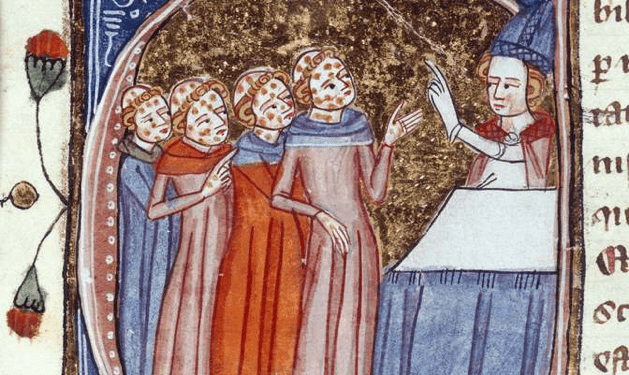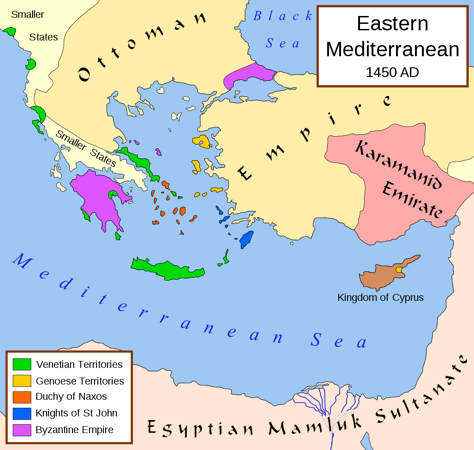Greek Diaspora History
The Black Death
The Black Death in the Byzantine Empire and Medieval Greece
The Black Death was a devastating global pandemic of the bubonic plague that wreaked havoc across Europe and Asia in the mid 14th Century. There are many accounts about the Black Death in Western Europe, but most recent publications on the Black Death appear to leave out the impact on the Byzantine Empire and the Greeks.
What was the Black Death?
The Black Death was a form of the bubonic plague and was the deadliest pandemic recorded in human history. Sometimes also referred to as “The Black Plague” or simply “The Bubonic Plague”, the Black Death resulted in the deaths of approximately 75–200 million people worldwide.
Today, we know that the disease was caused by the bacterium Yersinia pestis and was transmitted by fleas on animals such as wild rodents. The Black Death spread rapidly in over populated cities and fortifications as people and rodents lived in great numbers and density. Modern hygiene practices were also not present in the 14th Century, which contributed to the spread of the Black Death.
Symptoms of the bubonic plague
The early symptoms of the Black Death were swellings, either on the groin or under the armpits – some recorded swellings the size of an egg or an apple! The swellings would spread and turn into what was referred to as “plague boils”. Blood and pus would seep out of the plague boils. After some time, additional symptoms such as fever, chills, vomiting, diarrhea, and aches and pains would become present in patients – before their eventual death.
Which country caused the Black Death?
The Bubonic Plague that caused the Black Death originated in China in the early to mid 14th Century and spread via the Silk Road – through Asia, Europe, and North Africa.
How long did the Black Death last?
It is estimated that the Black Death lasted on and off for a total of 325 years, between 1346 and 1671. In Europe, the Black Death reached its peak in the five year period between 1347 and 1351.

How did the Black Death arrive in Europe?
Many sources first claim that the Black Death arrived in Europe via the Sicilian port of Messina on October 1347. The plague made its way through 12 ships that arrived from the Black Sea. The Sicilians were horrified to find that most of the sailors aboard the ships were dead and the remaining sailors were covered in black boils that seeped blood and pus.
The Black Sea, however, borders Europe. So how did the Black Death arrive around the Black Sea?
The first Europeans recorded to have contracted the Black Death were Genoese traders in the port city of Caffa in the Crimea in 1347. Caffa, also known as Theodosia or Kaffa, was a Genoese colony and served as their administrative capital for additional Genoese settlements around the Black Sea.
The Genoese traders contracted the Black Death after a siege of the city, between 1345 and 1346 by the Mongol Golden Horde army. The Mongol army had already been suffering from the plague and even catapulted infected corpses into Caffa as a siege tactic. After the outbreak of the plague in Caffa, the first European city to be impacted by the Black Death was nearby Constantinople, which also bordered the Black Sea.

The Byzantine Empire and Medieval Greece at the time of the plague
At the outbreak of the Black Death in Europe (1347), the Byzantine Empire (Eastern Roman Empire) had recently concluded the Byzantine Civil War of 1341-1347, sometimes referred to as the Second Palaiologan Civil War. The civil war resulted in an arrangement where John VI Kantakouzenos would reign as equal Emperor to John V Palaiologos (the grandfather of the last Byzantine Emperor – Constantine XI Palaiologos and rightful heir to the thrown). The prolonged internal conflict also resulted in territorial losses to the Serbs and Turks, as well as exhausting the empire’s resources. According to Eva de Vries-Van der Velden, it marks “the point of rupture between the ‘decline’ and ‘the fall’ of the Byzantine Empire”.

Earlier, one of the Byzantine Empire’s greatest foes – the Seljuk’s saw a decline in their Sultanate of Rum and the emergence of another Turkic empire – the Ottomans, founded in 1299. The Ottomans would gradually begin to capture Byzantine territory and lay a series of unsuccessful sieges of Constantinople in 1391, 1394-1396, 1397-1402, 1411, 1422 – until their successful siege of 1453, which led to the fall of Constantinople and the Byzantine Empire.

How did the Black Death impact the Byzantine Empire and Medieval Greece?
During the 14th Century
The equal emperor arrangement previously described did not last and John VI Kantakouzenos was dethroned in 1355, interestingly becoming a monk. Writings from John VI Kantakouzenos and the historian Nikephoros Gregoras are the main sources available today to ascertain the impact of the Black Death in the Byzantine Empire.
In 1347, in addition to Constantinople, the plague spread to Thessaloniki (the second largest city of the empire), Limnos, Euboea, Crete, Trebizond, and Methone and Koroni (Venetian naval bases in the Peloponnese). In 1348, the plague continued to spread to Rhodes (under the Order of the Knights of Saint John), Cyprus (under Venetian control), and the inner Peloponnese.
Between 1347 and 1351, the Black Death would kill almost one-third of Europe’s population – over 20 million people.
Although the Black Death appeared to subside and almost disappear in Europe after 1351, it would reappear in Constantinople in 1361. In 1362, trade with Constantinople spread the plague to the Empire of Trebizond (an Empire established by the former Byzantine Emperor – Alexios Komnenos in 1204). The Black Death continued to spread in 1362 once again to Limnos, Crete, the Peloponnese and Cyprus.
In 1368, the Black Death reached the Depotate of Epirus (a state established by the Angelos Byzantine dynasty in 1204), which resulted in one of the highest instances of Greek deaths due to the Black Death, with thousands dead in Ioannina alone. Then in 1372, Thessaloniki once again succumbed to the disease. In 1378, the Black Death reached the monastic state of Mount Athos.
1381 saw the Black Death resurface in the Peloponnese. Constantinople would also see a resurgence of the deadly plague in 1386. In 1388, the Black Death reaches the Duchy of Athens (established as a crusader state in 1204). Then in 1389, the Black Death resurfaced in Crete.
In 1391, the Black Death re-entered Constantinople during the Ottoman siege of the city. The plague would also resurface in Crete and the Peloponnese before the turn of the century.

During the 15th Century
The turn of the century saw the Black Death reach Corfu and resurface in Constantinople and Cyprus. Between 1410 and 1420, the deadly plague also resurged in Crete, the Peloponnese, and Epirus, while also reaching Kephalonia.
In 1422, the Black Death impacted both Greeks Byzantines and Ottoman Turks during the siege of Constantinople and resulted in the subsequent Ottoman withdrawal. In 1423, the plague resurged in Thessaloniki (then under Venetian control) during the Venetian and Ottoman conflict over the city. 1426 saw the resurgence of the plague in Euboia and in 1431 the Black Death returned to the Peloponnese and Constantinople.
In 1435, the Black Death ravaged Constantinople and Trebizond, and even claimed the lives of a papal envoy for the Synod of Ferrara regarding the union of the two Christian churches in return for the Pope’s help against the Ottomans.
In 1438, the plague returned to Cyprus. 1441 saw the last account of the Black Death in the Byzantine Empire, with resurgence in Constantinople and the Peloponnese. In 1445, the Black Death reached Chios (under Geneose control) and Thrace in 1448. Also in 1448, the Peloponnese and Euboia saw the return of the plague. 1450 would see a resurgence in Corfu.

Off course Constantinople and the remnants of the Byzantine Empire would fall to the Ottomans on the 29th of May, 1453. Rarely mentioned in regards to the decline and fall of the Byzantine Empire, the Black Death can certainly be seen as a contributing factor. Not only did the deadly pandemic weaken and exhaust the Byzantine Empire, but also significantly impacted negotiations and the arrival of reinforcements from Italy and the West to support the effort against the Ottomans.
How did the Black Death end?
A widely-accepted theory of how the Black Death ended was through the implementation of quarantines. Out of fear of contracting the plague, people began to remain in their homes and only leave when it was necessary. Some, who could afford to, even left the more densely populated cities in search of greater isolation.
Does the Black Death still exist?
It might surprise you to learn that the bubonic plague, that was referred to as the Black Death, still exists. In fact, the World Health Organization reports 1,000 to 3,000 new cases of the plague worldwide every year. The difference is, today the plague is treatable with antibiotics. If left untreated however, the plague can still result in death.
Was this the only instance of the plague that affected the Greeks?
Although the Black Death was the last large plague epidemic to affect the Greeks, there were a number of previous “plagues” that deeply impacted the Greeks.
Almost 600 years before the emergence of the Black Plague, the Byzantine Empire was recovering from the Plague of Justinian which ended in 750. The plague named after the Byzantine Emperor at the time, in part because he contracted the plague himself! Learn if Justinian survived the plague and find out more about the Plague of Justinian here, which was thought to be an earlier epidemic of the bubonic plague.
In ancient times, the Athenians were also devastated by a disease referred to as the Plague of Athens around 430 BC. Learn more about the Plague of Athens here.
Do you have an ancestral connection to the Byzantine and Medieval Greeks? Trace your ancestry to find out. There are a number of DNA tests available but the most common and most trusted of them all is Ancestry.com
